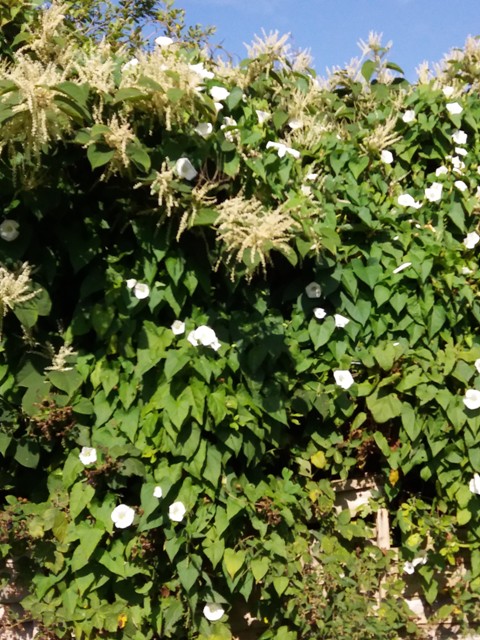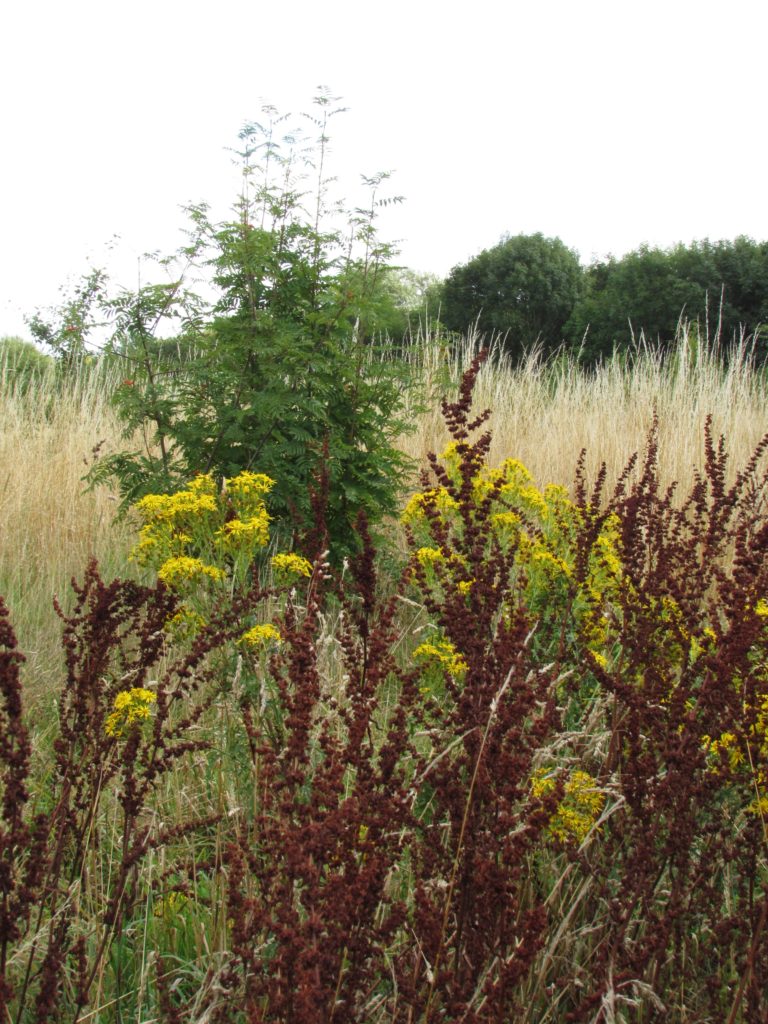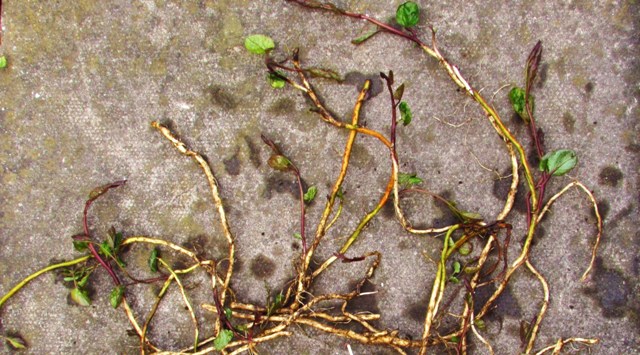To talk kindly about the weeds in my weekly blog, we first need to identify those weeds of which many people despise…!
I found the RHS website very useful please see here as well as how to tackle them.
I don’t really want to repeat what this brilliant website says, as my weekly blog wants to highlight the positive things about those weeds!
Weeds are also just being ‘themselves’; one of the many native plants of these Isles! They grow in soil and habitat in which they naturally like to grow in and often we are actually helping them greatly by providing a pleasant environment to thrive even more!
Troublesome weeds or innocent wildflowers?

Japanese Knotweed with Bindweed 
Broad-leaf dock & Ragwort
This website mentions over 20 most troublesome weeds, upon which I will hope to do a write up in the coming weeks.
But this blog is also about all our native plant which I think is worth you knowing about!
But even if we are actually not helping the soil, these weeds can thrive as they are designed to live in the most hostile conditions as well! You would not plant a Buddleia (Butterfly Bush) into a wall or an attractive flowering plant in between your slabs on your patio, but dandelion, herb-bennet, bindweed and various other weeds just love those conditions!
As weeds we can group them into the areas in which they would grow in nature and this gives us an indication as to where and how they grow best, so if we don’t want them we just have to provide the opposite.
Unfortunately it is not so easy to get rid of these weed as they are frequently very adaptable to many circumstances and this is probably why we call them weeds, as we don’t like it when things don’t behave as we want them to, overstep their mark, take advantages of the situation or are just too damned successful!
Well, I must confess that even I do get annoyed with these weeds if they are in the way of an area in which I would like to plant or use for different purposes.
It took me several hours recently to remove the bindwood-roots (or rhizomes in scientific terms) which had thrived in a leaf-heap on my allotment. So before I was able to spread the leaf-mould I had to prize out the roots bit by bit as every little bit left could possibly be another new plant!

the white rhizomes of bindweed or Calystegia sepium is number 6 in the list below.
The bindweed was already there of course for many years and it had even looked pretty on my small tunnel-frame last summer with its large white bells.
So we can group these weeds as to how and where they can cause trouble, either in our garden, allotment or drives……
We have the:
perennial weeds; “which come back every year” – sorry, just had to quote this from a very common saying heard in a local garden-centre, used by the staff to inform customers as to whether a plant is an annual plant (usually called ‘bedding plant’) or a perennial such as a shrub, tree or, a bit more difficult to understand/classify, a herbaceous perennial which can be deciduous (i.e. dying back to a rootstock each year), evergreen (i.e. foliage all year round), spreading (i.e. by roots often called rhizomes or above ground with stolons; such as our common strawberry) or clump forming and long-lasting or short-lived!
The annual weeds; these live only 1 year or even less as they usually die after they have flowered. Some weeds can even have many generations per year and if they are not attractive to us that is of course annoying.
Lawn-weeds: more about this specific group in another post here.
Trees and shrubs or woody weeds: often native species which produce massive amounts of wind-dispersed seeds such as the Willow, Common Alder, Birch, Ash or Sycamore trees especially. Then also the fruiting type of shrubs such as Common Elder or one of the many Cotoneasters and what about our native Blackberry (Bramble). This could be a problem when living in areas where many of these plants grow naturally and birds will eat and drop the seed as a result in some impossible place for us to get them out again.
Below follows a complete weed list of 23 main ones found on the RHS website . I have reduced the contents.
These and many other native plants are going to be and many have been covered in a more positive manner in my Weekly-Weed-blog
1) Dandelion: Their large yellow flowers and furry seed heads make them easily recognisable. They often invade lawns and can be difficult to get rid of in the border and in cracks in paving.
2) Woody perennial weeds:Trees and shrubs may pop up in your garden because a seed has been blown in by the wind or transferred by wildlife visitors to the garden. It is best to uproot these weeds as soon as you notice them and before they form an established root system, usually a long tap root. See more information on getting rid of woody weeds such as self-seeded trees popping up in the wrong place.
3) Green alkanet or Pentaglottis sempervirens
The pretty blue forget-me-not flowers are attractive but it soon becomes a weed in damp shady gardens. It is pollinated by bees and bumblebees and a brownish-red dye was extracted from its roots.
4) Herb bennet, wood avens or Geum urbanum
5) Couch grass, scutch grass, twitch grass or Elymus repens
Weed with creeping underground stems.
6) Hedge bindweed, bellbind (Calystegia sepium) and field bindweed (Convolvulus arvensis)
A twining & smothering weed with creeping underground stems (rhizomes)
7) Japanese knotweed or Reynoutria japonica: This is a weed that spreads rapidly. In winter the plant dies back to ground level, but by early summer, the bamboo-like stems emerge from rhizomes deep underground to shoot to over 2.1m (7ft), suppressing all other plant growth. Eradication requires determination as it is very hard to remove by hand or eradicate with chemicals. New legislation now covers its control.
8) Ground elder, gout weed, bishop weed, jump-about or Aegopodium podagraria
May establish from seed, but usually arrives via rhizomes from neighbouring gardens, or stem fragments in composts or manures.
9) Wood sorrel, yellow sorrel, pink sorrel or pink shamrock or Oxalis corniculata, debilis and O. latifolia
Spreads via bulbils and seed.
10)Lesser celandine, Pilewort or Ranunculus ficaria. Weed with persistent root tubers.
11)Enchanter’s nightshade or Circaea lutetiana
Weed with spreading stolons.
12) Cleavers, goosegrass, sticky willie or Galium aparine
Easily distributed seed produced in large quantities.
13) Herb robert or Geranium robertianum
Explosive seed pods spread the fine seed over a wide area.
14) Bittercress, Hairy Bittercress, Wavy Bittercress
Cardamine hirsuta (Hairy Bittercress), C. flexuosa (Wavy Bittercress)
weeds with explosive seed capsules.
15) Creeping Buttercup or Ranunculus repens
A weed with spreading runners and seeds. This weed’s presence often indicates the need for improvements to soil structure and drainage.
16) Nettle or Urtica dioica, U. urens: Perennial nettles (Urtica dioica) and the annual nettle (Urtica urens) are usually considered to be weeds, although if you have the space to leave some, they can be an excellent source of food and habitat for butterflies such as the red admiral, peacock and small tortoiseshell. It is perhaps most troublesome in loose, newly cultivated soil, especially where phosphate levels are high. The creeping surface stems can extend for some considerable distance, rooting at the nodes and producing aerial shoots.
17) Creeping thistle or Cirsium arvense
Thistles spread via creeping roots and air-borne seeds. They are brittle and readily re-shoot if broken. They should be controlled if you wish to grow garden plants in the area, since they compete for light, water and food.
18) Rosebay willowherb or fireweed or Chamaenerion angustifolium
A white cultivar, Chamaenerion angustifolium ‘Alba’ is available as a garden plant and shows less invasive tendencies than the pink form.
19) Chickweed or Stellaria media
Large numbers of easily distributable seed produced throughout the growing season.
20) Horsetail and often wrongly called mare’s tail: ‘The Mare’s Tail (Hippuris vulgaris) must not be confused with the Horsetail (Equisetum arvense). The Mare’s Tail is an aquatic flowering plant’ from May establish from spores, but usually arrives via rhizomes from neighbouring gardens, or stem fragments in composts or manures.
21) Broad-leaved dock (Rumex obtusifolius) and curled dock (R. crispus)
Thick tap root that can re-grow and has abundant seeds
22) Shepherds purse (Capsella bursa pastoris). Rosettes of leaves grow all year round, sending up characteristic heart-shaped seed pods after white flowers. Buried seeds can still germinate after 30 years of lying dormant in the soil, so prevent a potential problem by removing plants and seed heads as soon as you spot them.
23) Groundsel (Senecio vulgaris): Produces seeds all year round. Although hoeing seedlings is effective, remove the larger uprooted plants as these can still set seeds that germinate. Seeds spread on the wind, but only last a few years in the soil.
